
Colombia has an unmistakable rhythm to life. Its cities are dynamic, colourful and full of life, while its landscapes offer incredibly varied yet stunningly lovely vistas and landmarks. Colombia is celebrated for its artists, writers and gastronomy which year upon year attract tourists to its shores.
Columbia is surrounded by the Pacific Ocean, the Caribbean Sea and five other South American countries, Colombia has a prosperous and diverse culture shown through its architecture, festivals and food. It is rapid becoming a must-visit country when travelling to South America, thanks to ongoing tourism projects. So, if Colombia is on your bucket list, here are 20 natural and historical Columbia landmarks that make it one of the best countries to visit in South America. If you’re itching to visit Columbia right away, here are some Spanish shows on Netflix featuring places in Columbia.
20 Famous Landmarks in Colombia
Natural Landmarks in Colombia
1- Guatape Rock
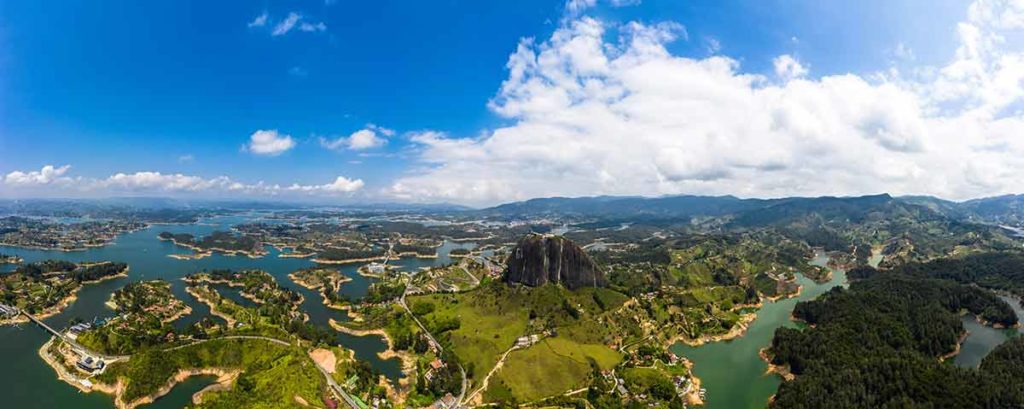 The Rock of Guatape is one of Colombia’s celebrated landmarks.
The Rock of Guatape is one of Colombia’s celebrated landmarks.
The local indigenous people worshipped Guatape Rock which is now a national monument.
Today the rock has a zig-zag pathway, gradually scaling the high sides of the rock to reach the top, however in the 1950s three local men scaled this Colombian landmark for the first time, taking them five days to complete the climb.
The top of the rock has stunning views over the reservoir and islands.
Guatape Rock is in Guatape, Antioquia. Find out more here.
2- Monserrate
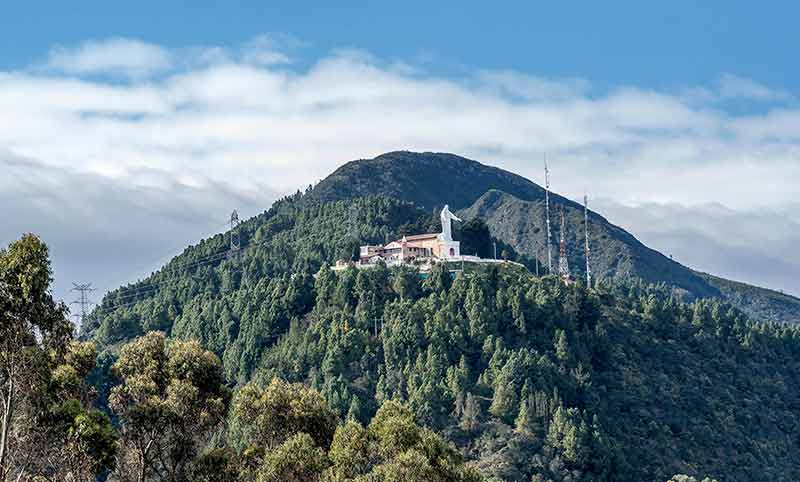 Monserrate Church is a Bogota landmark to tick off your list of monuments to see in Colombia.
Monserrate Church is a Bogota landmark to tick off your list of monuments to see in Colombia.
The people of Bogotá consider Monserrate, which towers above the city, a symbol of spirituality and strength.
Monserrate’s summit is 3512m (11,522ft) above sea level and offers incredible views over the jungle and the city below.
The summit is reachable by cablecar, funicular or by hiking. Atop the mountain is a tiny church also named Monserrate.
The church is a popular pilgrimage destination for Christians and tourists, particularly during Christmas when decorated with colourful lights.
Within the church is a celebrated shrine to El Señor Caído, The Fallen Lord. Skip the line and book a tour and tickets here.
Monserrate is in Bogota and if you’re visiting, here’s a fabulous luxury hotel in Bogota to stay.
3- Cocora Valley
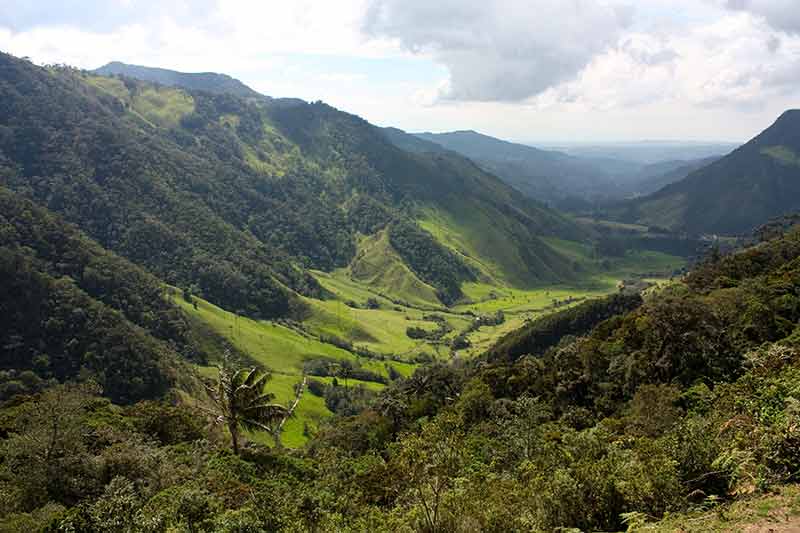 The Cocora Valley is a lush green Columbian landmark of nature.
The Cocora Valley is a lush green Columbian landmark of nature.
Cocora Valley is in Las Nevados National Park, a luscious green landscape of the Andes range.
The valley is filled with Quindio wax palms, the national tree of Colombia.
Cocora Valley’s palm trees are the tallest variation of palms globally, with the tallest reaching 60m (200ft).
The valley gives visitors a feeling of stepping back thousands of years due to the towering palms, long grasses and mist-covered mountains.
There are three recommended hikes of the valley, with the shortest taking hikers straight to the palm trees in 30 to 45 minutes and the longest taking in the whole valley and the Hummingbird house in a six-hour loop.
Cocora Valley is in Salento, Quindio. Here’s a full-day tour to check out.
4- The Coffee Triangle
The Coffee Triangle is an area in the Colombian jungle where coffee growing is at its densest.
This region’s climate and landscapes are perfect for growing coffee in the right conditions.
Due to its cultural significance, the area is a UNESCO World Heritage status.
While the landscape is lovely and well worth exploring, head to the tiny town of Salento, which is a charming picture of established and colourful architecture.
Tours of coffee plantations are popular throughout the area, with Pijao hosting a popular day-long experience.
The Coffee Triangle is at Caldas, Risaralda and Quindio departments.
5- Tatacoa Desert
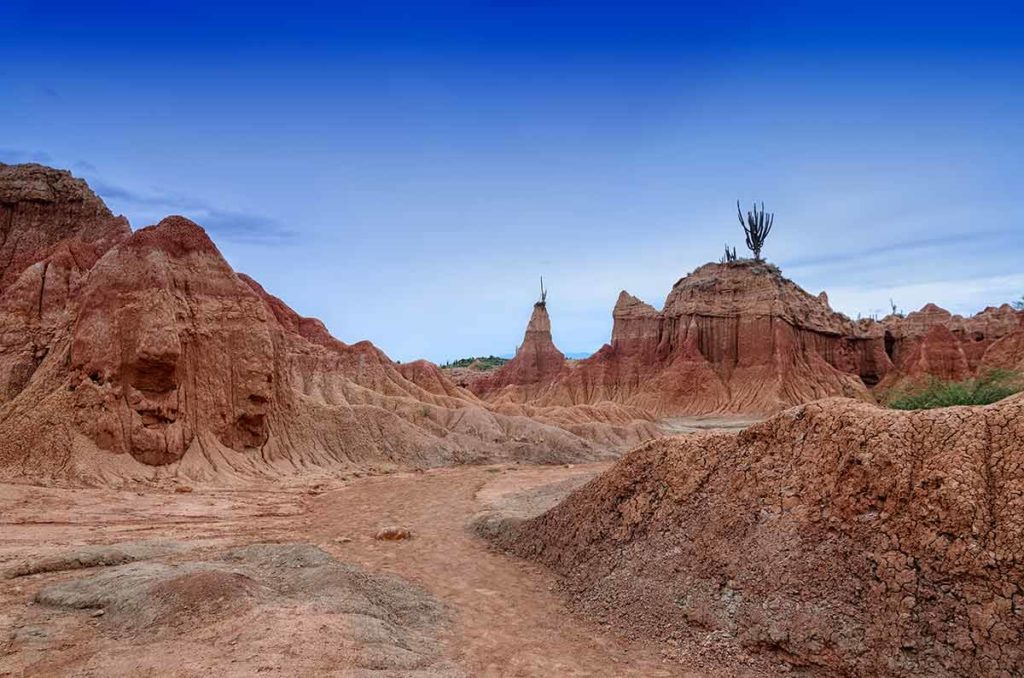 The Tatacoa Desert of Colombia is a one of its attractions with many stunning landmarks.
The Tatacoa Desert of Colombia is a one of its attractions with many stunning landmarks.
Tatacoa Desert is in Colombia’s central department of Huila. Colombia has 32 departments, each with a governor and assembly elected by the people.
The otherworldly landscape has made the desert a popular location for tourists to hike, explore and stargaze in its clear night skies.
The desert is unique because it has two landscapes.
The red landscape features rippled red stone in tiny peaks, creating gullies and valleys dotted with cacti.
The grey landscape offers an almost moon-like terrain.
Within the red desert is an observatory that hosts regular talks on astronomy and allows visitors access to its powerful telescope.
Tatacoa Desert is at Villavieja, Huila. Find out more here.
6- Termales de Santa Rosa de Cabal
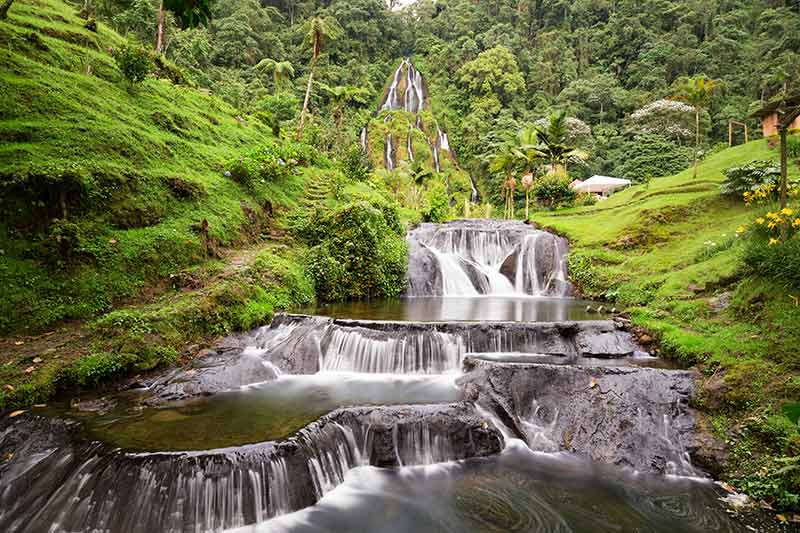 The lovely waterfall near the Santa Rosa thermal springs is one of the natural landmarks in Colombia
The lovely waterfall near the Santa Rosa thermal springs is one of the natural landmarks in Colombia
Termales de Santa Rosa de Cabal, or Santa Rosa Hot Springs, is one of Colombia’s most celebrated warm springs due to its spectacular location.
The warm springs are at the bottom of a lush forest-covered mountain, water flowing into it from waterfalls above.
The water in the pools is tasteless and odourless.
It is believed that the waters will lend a hand to relieve ailments, and so the springs are popular for locals and tourists.
The waters average 20°C and a dip is just the remedy for a steamy day in the tropics.
Santa Rosa Hot Springs is at Risaralda, Eje Cafetero. Find out more here.
7- El Cocuy Glacier
Although Colombia is a country with national parks of incredible beauty, Parque El Cocuy is a hidden gem.
The national park was glacially formed and is a landscape of glaciers, meltwater lakes, snowy-peaked mountains and forested valleys.
Within the national park are the spectacular glaciers and the glacier zone of the park is the largest in South America north of the equator.
Sadly like many of the world’s glaciers, the glaciers in El Cocuy are predicted to vanish within 20 to 30 years.
El Cocuy Glacier is at El Cocuy National Park, El Cocuy. Go trekking in the El Cocuy Mountain Range with a guide.
8- Los Estoraques
Los Estoraques is a unique natural area celebrated for its unusual rock formations.
The park itself is one of the smallest in Colombia but what it lacks in size, it makes up for in its captivating scenery.
Los Estoraques has deep canyons carved into the rocks that stretch upwards, caves, wooded valleys and many nature trails.
This area that is rarely visited by tourists has a stunning landscape that makes for incredible photographs.
Over the years, wind and rain eroded the rocks within the park, creating towers or monoliths stretching out from the wooded ground below.
The area is often called a “dry forest” because of its unusual appearance.
It is possible to climb to the top of some of the rocks for even more spectacular views.
Los Estoraques is at La Playa De Belen, North Santander.
9- Cano Cristales
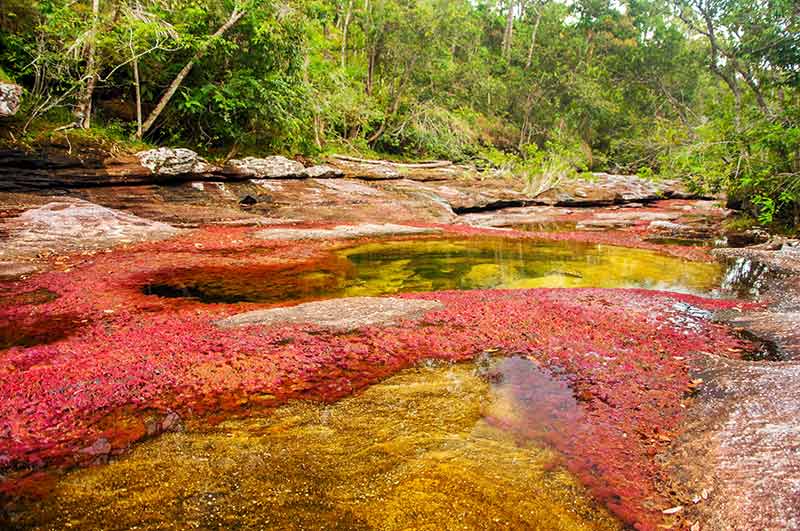 Red and yellow river in Colombia is a landmark of nature.
Red and yellow river in Colombia is a landmark of nature.
A stunning river of the world, Cano Cristales is a magical must-visit natural landmark in Colombia.
Between June and December, the river takes on a spectacular form and transforms into a rainbow of colour, with red, green, yellow, blue and black hues evident.
The colours are caused by an aquatic plant called macaroni clavier, that changes colour in particular water and airy levels.
Atop of the river’s incredible colour, there are many circular holes and waterfalls along its length, giving it an unusual appearance.
Cano Cristales is at Serrania de la Macarena National Park, Meta. Find out more here.
10- Tequendama Falls
The 157m (515ft) Tequendama Falls is part of the Bogota River and is Colombia’s most celebrated.
According to local Muisca legend, the falls formed when Bochica, a god of the Muisca people, blew from his staff to rid the Bogota Savannah of floodwaters.
As he did, the water was pushed off the mountain creating the falls.
The falls’ best viewpoint is from the Hotel Del Salto, a gothic hotel that opened in the tardy 1920s.
Tequendama Falls is at San Antonio Del Tequendama, Soacha, Cundinamarca.
Historical Colombian Landmarks
11- Cerro Azul
One of the historical sites of importance in Colombia is Cerro Azul.
The rock paintings here are truly an incredible landmark in Colombia of historical significance.
While the jungles surrounding the artworks feature a few examples of age-old human life, Cerro Azul’s are the most defined and well-preserved.
The dynamic red paintings on a paler rock face depict animals, people and nature.
One particular point of interest is the depiction of giant land sloths, which became extinct in South America over 11,000 years ago.
Cerro Azul is at San Jose del Guaviare. Find out more here.
12- Castillo San Felipe de Barajas
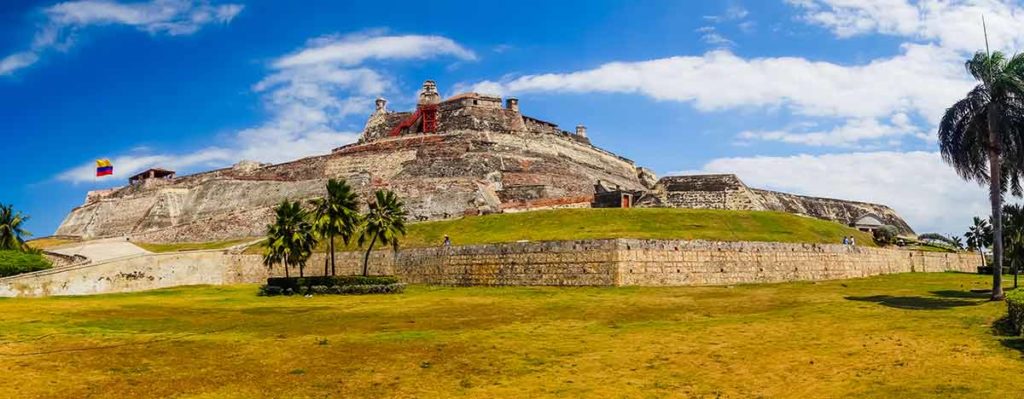 Castillo San Felipe Barajas is a historic Colombian landmark to visit.
Castillo San Felipe Barajas is a historic Colombian landmark to visit.
Castillo San Felipe de Barajas is a walled fortress in Cartagena.
Built strategically on San Lazaro Hill, the castle has excellent views across the sea and land.
The castle was built in 1536 and expanded in 1657 to accommodate more soldiers and gunners.
A labyrinth of tunnels was built underneath the castle to strengthen its defences further, as soldiers could transport weapons, artillery and more men without being seen by enemy forces.
The castle is remarkably well preserved, and it became a UNESCO World Heritage Site in 1984, alongside the city’s historic centre.
Castillo San Felipe de Barajas is at Barrio Pie del Cerro, Avenida Antonio de Arévalo, Carrera 17, Cartagena, Bolívar. Find out more here.
13- Ciudad Perdida
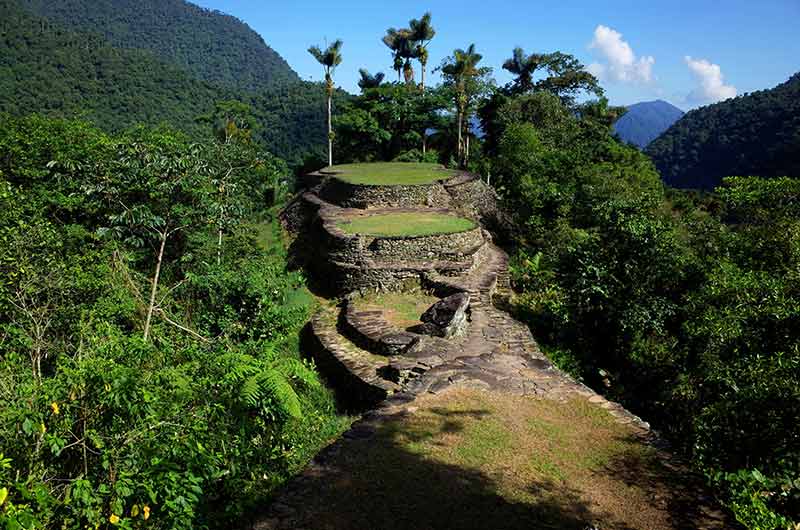 La Ciudad Perdida is one of the celebrated landmarks in Colombia.
La Ciudad Perdida is one of the celebrated landmarks in Colombia.
Often referred to as ‘The Lost City’, Ciudad Perdida is believed by archeologists to have been founded in 800AD by the Tayrona people.
It was founded more than 650 years earlier than Machu Picchu.
Initially discovered by looters before the first archeologists arrived, Ciudad Perdida sits high up in the isolated Sierra Nevada mountain range.
Within the site are burial grounds filled with golden treasures, most sadly taken by looters.
Reaching Ciudad Perdida is a challenging five-day trek through a staggeringly lovely jungle before reaching the age-old ruins’ serene solitude.
Ciudad Perdida is at Ciudad Perdida, Santa Marta, Magdalena, Colombia.
14- Catedral de Sal de Zipaquira
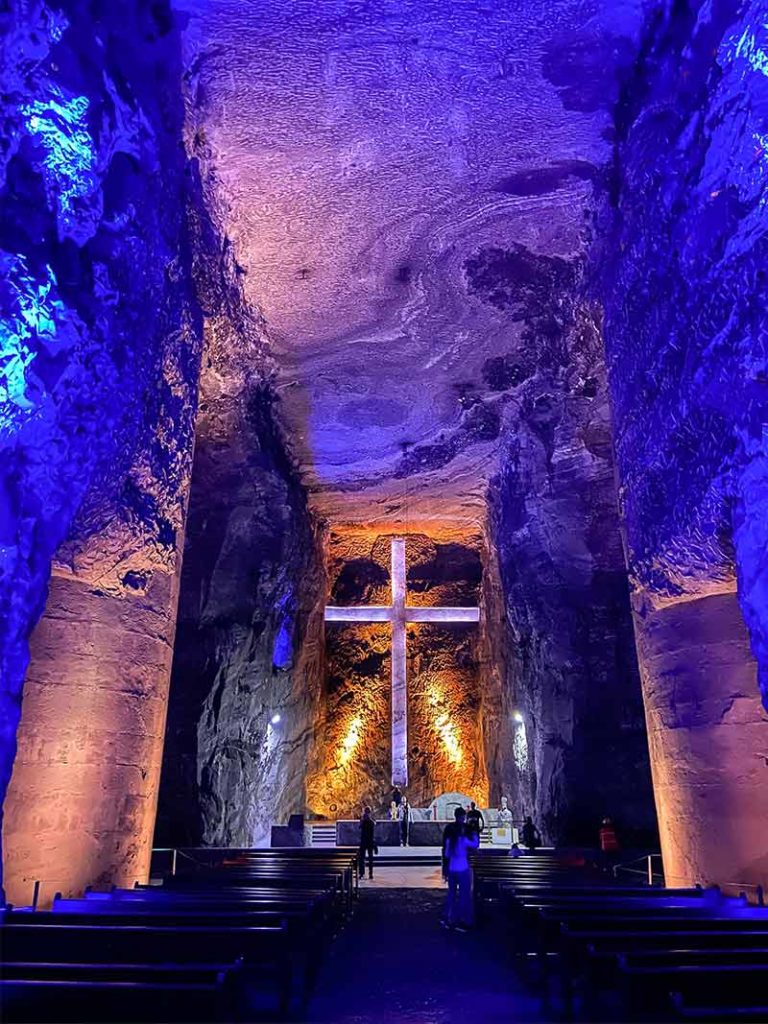 The Salt Cathedral in Zipaquira is one of the most unusual monuments in Columbia.
The Salt Cathedral in Zipaquira is one of the most unusual monuments in Columbia.
One of Colombia’s more unique historical landmarks is Cathedral de Sal de Zipaquira (Zipaquira Salt Cathedral).
Miners built the cathedral as a place where they could find solitude and pray before beginning work, and it could hold up to 8000 people inside.
In 1995 the cathedral was rebuilt due to concerns over the structural integrity of the aged church.
The cathedral is inside a shaft at the now-abandoned mine, 200m (656ft) underground, and is a pilgrimage site popular during the Easter period.
Zipaquira Salt Cathedral is at Calle 3 8-36, Zipaquira.
15- Las Lajas Sanctuary
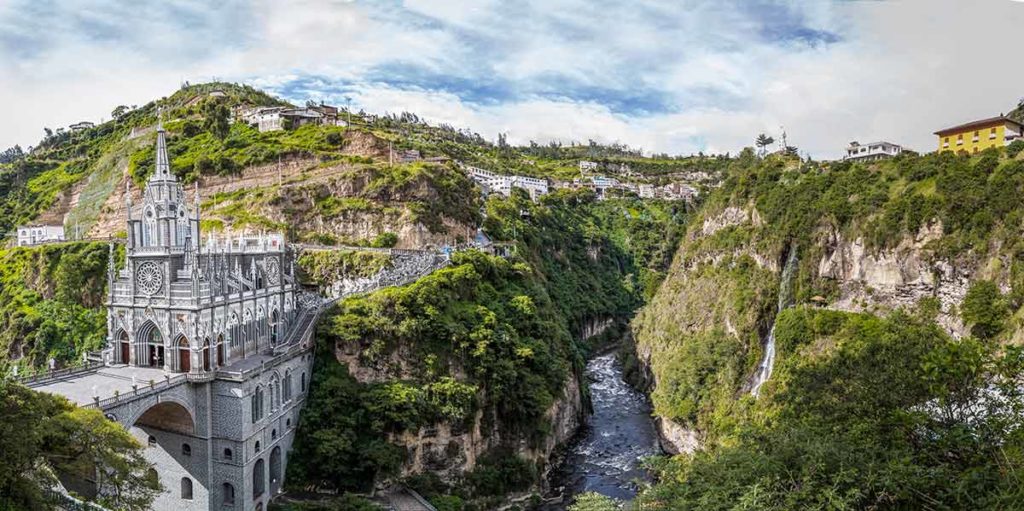 Las Lajas Sanctuary is one of the celebrated Colombia landmarks to tick off your bucket list.
Las Lajas Sanctuary is one of the celebrated Colombia landmarks to tick off your bucket list.
Las Lajas Sanctuary is a uniquely placed church in the southern department of Narino.
The church, accessible by an arch bridge, sits 100m (330ft) above the Guaitara river below in a green and peaceful valley.
Las Lajas was built in the Gothic Revival style and features a cross-shaped roof.
Its unique placement is definitely worth the journey into the valley.
The sanctuary is steeped in mystery and legend.
A mural within the sanctuary has completely unknown origins.
According to legend, the Holy Virgin appeared to a youthful woman and her deaf-mute daughter as they sought shelter from a raging storm at the churches site.
Las Lajas Sanctuary is at Ipiales, Potosi.
16- Cartagena Cathedral
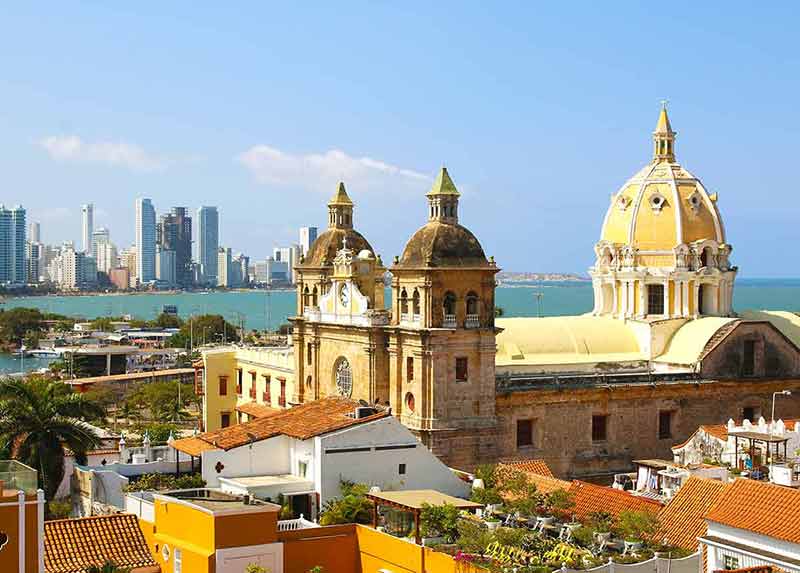 Cartagena Cathedral is one of the architecturally stunning Colombian landmarks.
Cartagena Cathedral is one of the architecturally stunning Colombian landmarks.
Master builder Simon Gonzales designed Cartagena Cathedral in the tardy 1500s, with construction beginning in 1577.
Gaston Lelarge, a French architect, designed the current tower as part of 20th-century renovations on the cathedral.
The cathedral was severely damaged during its construction following an attack by Sir Francis Drake, which also delayed its completion.
The cathedral is not difficult to spot, with its brilliant yellow facade and iconic domed tower.
The cathedral has many celebrated frescos, a marble pulpit and an 18th-century gilded altar.
Cartagena Cathedral is at Calle de los Santos de Piedra, Cra. 4, Cartagena. Explore the cathedral and other sights on this fun scooter ride through Cartagena.
17- Nabusimake
Nabusimake is the capital and spiritual centre for the Arhuaco people.
Translating to “the land where the sun is born”, Nabusimake is in the Sierra Nevada mountains.
Within the beauty of the landscape are tiny settlements where the Arhuaco people live in straw-topped homes.
Walking through the area with a local guide will reveal tales of the mountains being sleeping gods, the belief that all life comes from the Sierra Nevada range, and of the spiritual ties with the world.
Nabusimake is at Valledupar, Cesar.
18- San Agustin Megaliths
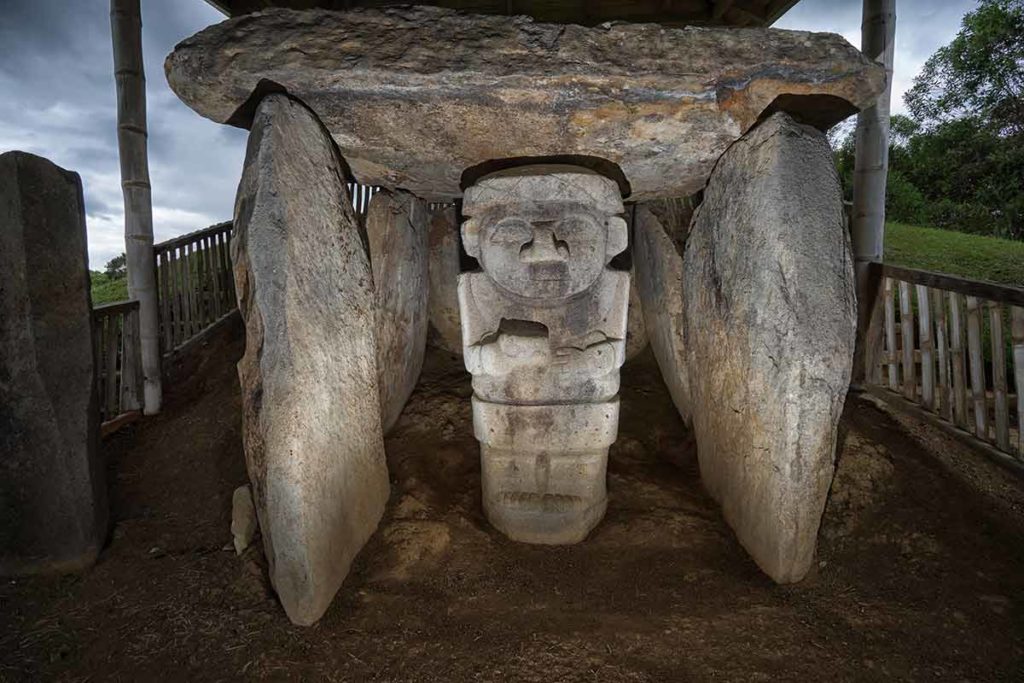 The San Augustin statues are historical Colombian monuments of note.
The San Augustin statues are historical Colombian monuments of note.
The megaliths of San Agustin date back to approximately 2000 years ago.
The megaliths, carved in the San Agustin style, represent animals such as crocodiles and jaguars and anthropomorphic humanoids with unusual features.
The megaliths were a part of burial and funeral ceremonies for the Upper Magdalena Valley people.
Approximately 500 megaliths have been unearthed by archeologists, making the San Agustin megaliths the most extensive collection of pre-Hispanic monuments in South America.
The megaliths were sculpted from volcanic clay and were painted in brilliant colours and polished to a shine.
San Agustin Megaliths is at Rio Magdalena, Huila. You may like this cultural tour of San Agustin.
19- Alto De Las Piedras
Alto De Las Piedras was a tiny village that dated from 1000 BC to 1AD.
The village became a burial site until 900AD, when it was abandoned.
The site sits at 1830m (6003ft) above sea level within the National Archeological Park of San Agustin.
Alto De Las Piedras features many tombs cut deep into the earth and painted in yellow, black or red.
Unlike other burial areas in South America from the same period, some of Alto De Las Piedras’ tombs were designed specifically for children.
Much of the archeological finds were destroyed by looters and treasure hunters, however, several statues and sculptures are now on display.
Alto De Las Piedras is at the National Archeological Park of San Agustin, San Agustin.
20- La Lindosa Guaviare Rock Art
La Lindosa Guaviare is home to thousands of unique rock art paintings and engravings.
The rock art is within Chiribiquete National Park, Colombia’s largest national park.
The paintings’ scale is extensive, with scientists and archeologists unearthing approximately eight miles (12 kilometres) of symbols and paintings.
As seen in other examples of rock art within Colombia, a red pigment gathered from minerals was used to paint examples of local flora, fauna and animal life.
Many scenes painted at La Lindosa reflect hunting for guanacos, closely related to llamas.
La Lindosa Guaviare Rock Art is at Chiribiquete National Park, Solano, Guaviare.

